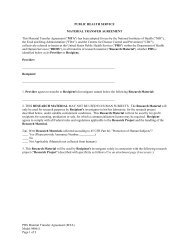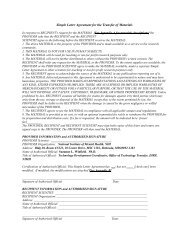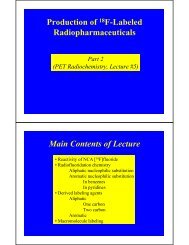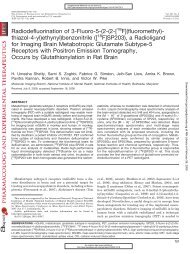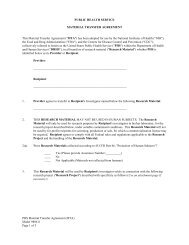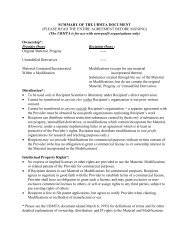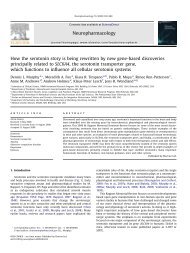Production of 18F-Labeled Radiopharmaceuticals
Production of 18F-Labeled Radiopharmaceuticals
Production of 18F-Labeled Radiopharmaceuticals
You also want an ePaper? Increase the reach of your titles
YUMPU automatically turns print PDFs into web optimized ePapers that Google loves.
<strong>Production</strong> <strong>of</strong> 18 F-<strong>Labeled</strong><br />
<strong>Radiopharmaceuticals</strong><br />
Part 1<br />
(PET radiochemistry lecture #4)<br />
Contents <strong>of</strong> Lecture<br />
• Properties <strong>of</strong> fluorine<br />
• <strong>Production</strong> <strong>of</strong> fluorine-18<br />
• Classical radi<strong>of</strong>luoridation methods<br />
• ‘Electrophilic’ radi<strong>of</strong>luorination chemistry<br />
- labeling agents<br />
- labeling chemistry
Some Properties <strong>of</strong> Fluorine<br />
- Electronic<br />
H F Cl Comment on F<br />
Electronic configuration 1s 1 …2s 2 2p 5 ..3s 2 3p 5 More electrons than H!<br />
F is isoelectronic with OH<br />
Electonegativity (Pauling) 2.1 4.0 3.0 Major effects on neighboring<br />
groups (pKa and reactivity)<br />
Electron affinity (kJ/atom) a 73 328 349 e-pair repulsions important<br />
with F!<br />
Ionisation energy (kJ/g atom) b 1260 1612 1200 F + less likely than X +<br />
a<br />
X + + e - X<br />
b<br />
X + e - X -<br />
Some Properties <strong>of</strong> Fluorine<br />
- Steric<br />
H F Cl Comment on F<br />
Atomic radius (Å) 0.53 0.42 0.79 F similar to H<br />
Van der Waal’s radius (Å) 1.20 1.47 1.75 F intermediate
Some Properties <strong>of</strong> Fluorine<br />
- Bonding<br />
H F Cl Comment on F<br />
Bond energies <strong>of</strong> C-X (kJ/mole) a 400 464 ~ 320 Greater thermal<br />
stability<br />
Bond lengths <strong>of</strong> C-X (Å) b 1.091 1.317 1.766 Steric effect less<br />
important with F<br />
than Cl<br />
H-bonding √ √ X F may mimic OH<br />
Preference as a leaving group H + F - Cl - Contrasting<br />
chemistry<br />
a<br />
For CX 4<br />
d<br />
Covalent radii in CX 4<br />
Properties <strong>of</strong> Fluorine<br />
- Lipophilicity<br />
H F Cl Comment on F<br />
Alkyl-C-X (ΔlogP) 0.23 -0.38 0.06 F not lipophilic<br />
Aryl-C-X (ΔlogP) 0.23 0.37 0.94 F not very lipophilic<br />
LogP = log <strong>of</strong> partition coefficient (P) between octanol and water
Decay Characteristics <strong>of</strong> 18 F<br />
18<br />
F decay: 96.9% by β + -emission<br />
3.1% by EC<br />
Decay product:<br />
18<br />
O<br />
Half-life:<br />
109.8 min<br />
Maximal positron energy: 0.635 MeV<br />
Maximal positron range: 2.4 mm in water<br />
Why is Fluorine-18 Useful for<br />
Imaging?<br />
• Half-life <strong>of</strong> 18 F allows the study <strong>of</strong> longer processes than 11 C<br />
• The positron range is shorter than for 11 C<br />
• Aryl C–F bonds are generally stable in vivo<br />
• Many drug molecules contain F, and are possible candidates<br />
for isotopic labeling, and for radioligand or radiotracer<br />
development<br />
• Compounds may be labeled by adding groups containing 18 F<br />
(non-isotopic labeling)<br />
• A mono-fluoro derivative <strong>of</strong> an endogenous compound may<br />
pass as a steric equivalent in vivo, to the extent that it is<br />
accepted as a substrate by the first enzyme encountered on<br />
its metabolic pathway
[ 18 F]2-Fluoro-2-deoxy-D-glucose<br />
(FDG)<br />
HOH<br />
HO<br />
HO<br />
H<br />
H<br />
Extracellular<br />
H O<br />
18 F<br />
H.OH<br />
Intracellular<br />
hexokinase<br />
HOPO - 3<br />
H O<br />
HO<br />
HO<br />
H<br />
H<br />
18 F<br />
H.OH<br />
• FDG mimics endogenous glucose in that it is susceptible to<br />
phosphorylation by hexokinase<br />
• However, unlike glucose-6-phosphate, the generated 2-<br />
fluoro-glucose-6-phosphate resists further enzymatic<br />
transformation and so becomes entrapped intracellularly<br />
• FDG is therefore widely used to measure regional glucose<br />
metabolism with PET<br />
[ 18 F]L-6-Fluoro-DOPA (FDOPA)<br />
• FDOPA mimics the anti-Parkinsonian drug, L-DOPA<br />
• FDOPA is taken up into brain dopaminergic neurons, and is<br />
decarboxylated<br />
• Placement <strong>of</strong> the 18 F in the remote 6 position has least affect<br />
on the pK a <strong>of</strong> the OH groups, and hence the<br />
radiotracer is handled by the decarboxylase enzyme<br />
in a very similar manner to the parent drug, L-DOPA<br />
• FDOPA is widely used in PET neurological studies to mark<br />
dopaminergic neurons
[ 18 F]L-6-Fluoro-DOPA (FDOPA)<br />
- Neuronal uptake<br />
18 F<br />
Blood<br />
OH<br />
OH<br />
NH 2<br />
COOH<br />
BBB<br />
Dopaminergic neuron<br />
OH<br />
18 F<br />
OH<br />
NH 2<br />
COOH<br />
18 F<br />
DOPA<br />
decarboxylase NH 2<br />
OH<br />
OH<br />
Data for Some Important<br />
Reactions Producing 18 F<br />
Reaction Target ThresholdMaximal Energy at Calculated<br />
isotope energy cross maximal thick<br />
section cross target yield<br />
section at saturation<br />
(%) (MeV) (mb) (MeV) (GBq/μA)<br />
16<br />
O( 3 He,p) 18 F 99.76 0<br />
plus ~ 400 ~ 8 1.35 (E 3He<br />
= 35 MeV)<br />
16<br />
O( 3 He,n) 18 Ne a 99.76 3.8<br />
16<br />
O(α,pn) 18 F 99.76 23.2 ~ 136 36 1.00 (E α<br />
= 40 MeV)<br />
18<br />
O(p,n) 18 F 0.205 2.5 ~ 700 5 4.07 (E p<br />
= 8 MeV)<br />
8.88 (E p<br />
= 16 MeV)<br />
20<br />
Ne(d,α) 18 F 90.5 0 ~ 230 6 1.89 (E d<br />
= 8 MeV)<br />
2.81 (E d<br />
= 10 MeV)<br />
a 18<br />
Ne Decays to 18 F with a half-life <strong>of</strong> 1.67 s
<strong>Production</strong> <strong>of</strong> CA [ 18 F]Fluorine (1)<br />
- By deuteron irradiation <strong>of</strong> neon-0.1% fluorine<br />
20 Ne(d,α)<br />
18 F*<br />
' hot atom'<br />
• Deuteron irradiation <strong>of</strong> neon with added fluorine (~ 0.1%<br />
v/v) at a pressure up to 25 bar in a nickel target gives<br />
CA [ 18 F]fluorine<br />
• High beam currents (e.g. 50 µA) <strong>of</strong> 10 MeV deuterons<br />
or<br />
• low beam currents (e.g. 20 μA) <strong>of</strong> 17 MeV deuterons<br />
give useful activities<br />
<strong>Production</strong> <strong>of</strong> CA [ 18 F]Fluorine (1)<br />
- By deuteron irradiation <strong>of</strong> neon-0.1% fluorine<br />
18 F *<br />
(cont’d)<br />
F 2<br />
Ni wall<br />
18 F-F<br />
Ni<br />
18 F<br />
• Nucleogenic 18 F ( 18 F*) may exchange with added fluorine or<br />
diffuse to the target wall to be adsorbed as nickel fluoride<br />
• > 0.1% fluorine (60–250 μmol) is needed for efficient<br />
exchange<br />
• Monel or nickel targets, passivated with fluorine (1%) during<br />
irradiation, give good recovery (~ 70%) <strong>of</strong> radioactivity as<br />
[ 18 F]fluorine
<strong>Production</strong> <strong>of</strong> CA [ 18 F]Fluorine (2)<br />
- Via proton irradiation <strong>of</strong> 18 O-enriched oxygen<br />
[ 18 O]O 2<br />
Proton irradiation<br />
18 F*<br />
Ni- wall<br />
Ni<br />
18 F<br />
18 F-F<br />
1. Reclaim [ 18 O]oxygen<br />
2. Add F 2 /Kr<br />
3. Reirradiate<br />
• Proton irradiation <strong>of</strong> [ 18 O]oxygen in a nickel target, followed by<br />
cryogenic recovery <strong>of</strong> the precious target material, leaves<br />
18<br />
F attached to the target walls<br />
• Re-irradiation <strong>of</strong> the target filled with a noble gas plus fluorine<br />
gives CA [ 18 F]fluorine<br />
• This process gives greater activity and specific radioactivity<br />
than the 20 Ne(d,α) 18 F reaction; ~ 60% <strong>of</strong> the radioactivity<br />
is recovered with only 30 μmol <strong>of</strong> added fluorine.<br />
<strong>Production</strong> <strong>of</strong> CA [ 18 F]Fluorine (3)<br />
- Via proton irradiation <strong>of</strong> 18 O-enriched water<br />
H 2<br />
18 O<br />
18 F - (H 2 18 O) n<br />
18 F<br />
- (H2<br />
16 O)n<br />
Proton<br />
irradiation<br />
Dehydration<br />
18 F<br />
-<br />
Nucleophilic<br />
substitution<br />
CH 3 I<br />
CH 3<br />
18 F<br />
Electrical<br />
discharge<br />
18 F-F<br />
F 2<br />
•[ 18 F]Fluorine can be produced at a high CA specific radioactivity (~ 20<br />
GBq/μmol; 500 mCi/μmol) from NCA [ 18 F]fluoride<br />
• The final stage involves an electrical discharge for exchange <strong>of</strong> fluorine-18<br />
between [ 18 F]fluoromethane and a trace <strong>of</strong> added fluorine
<strong>Production</strong> <strong>of</strong> CA<br />
‘[ 18 F]Hydrogen Fluoride’<br />
• 18 F can be produced by the 20 Ne(d,α) 18 F reaction on Ne<br />
containing 15% H 2 in Inconel targets<br />
• To retrieve the radioactivity in anhydrous form the target<br />
must be heated and flushed with a noble gas<br />
• However, reproducible and efficient recovery is notoriously<br />
difficult to achieve unless carrier is generated within<br />
the target by some means, for example by adding CF 4<br />
to the target gas<br />
• The recovered radioactivity is putatively anhydrous<br />
[ 18 F]HF, but may, on the basis <strong>of</strong> its thermal<br />
properties, be some other chemical form, such as<br />
[ 18 F]NH 4 F<br />
<strong>Production</strong> <strong>of</strong> NCA<br />
‘[ 18 F]Hydrogen Fluoride’<br />
[ 18 O]O 2<br />
Proton irradiation 18<br />
F*<br />
Ni- wall<br />
Ni<br />
18 F<br />
H 18 F<br />
1. Reclaim oxygen<br />
2. Add H 2<br />
3. Heat target<br />
• NCA "anhydrous [ 18 F]hydrogen fluoride" may be produced by<br />
the 18 O(p,n) 18 F reaction on 18 O-enriched oxygen, followed<br />
by cryogenic recovery <strong>of</strong> the target material and recovery<br />
<strong>of</strong> the radioactivity from the target by heating during a<br />
hydrogen sweep
NCA [ 18 F]Fluoride (1)<br />
- By proton irradiation <strong>of</strong> 18 O-enriched water<br />
• Targets may use < l mL <strong>of</strong> 18 O-enriched water<br />
• Target materials containing Cr, Fe or Co are undesirable, as they<br />
possibly produce unreactive [ 18 F]metal fluorides, but Ni,<br />
Ti and Ag are acceptable<br />
• Though 18 O-enriched water is expensive, it can be re-used after<br />
distillation or after recovery <strong>of</strong> the [ 18 F]fluoride by, for<br />
example, adsorption on an anion exchange column<br />
• The process is intrinsically high yielding<br />
• Very high specific radioactivities can be achieved from fluoridefree<br />
water<br />
NCA [ 18 F]Fluoride (1)<br />
- By proton irradiation <strong>of</strong> 18 O-enriched water<br />
(cont’d)<br />
18 O(p,n) 18 F 18 F - (H 2 18 O) n<br />
Anion<br />
H 2 18 O<br />
1.<br />
(H 2 18 O) n<br />
for reuse<br />
2.<br />
3.<br />
4.<br />
exchange<br />
resin<br />
5.<br />
18 F - (H 2 16 O) n<br />
K 2 CO 3<br />
soln.<br />
Key:<br />
1. Irradiate<br />
2. Load product onto resin<br />
3. Recover irradiated water<br />
4. Elute resin<br />
5. Collect [ 18 F]fluoride
NCA [ 18 F]Fluoride (2)<br />
- By irradiation <strong>of</strong> natural water<br />
α-irradiation<br />
H 2 16 O<br />
3 He 2+ -irradiation<br />
18 F - (H 2 16 0) n<br />
•NCA [ 18 F]fluoride can be produced by irradiating water with<br />
high energy (> 24 MeV) α-particles, or, for higher yield,<br />
lower energy 3 He 2+ ions.<br />
• These processes are low yielding relativeto the proton<br />
irradiation <strong>of</strong> oxygen-18 and are seldom used.<br />
Some Typical <strong>Production</strong><br />
Parameters for 18 F<br />
<strong>Production</strong> Irradiation Main Typical Typical<br />
reaction conditions product(s) yield specific<br />
radioactivity<br />
(MeV, μA, min) (GBq) (GBq/μmol)<br />
d on 20 Ne (0.1% F 2<br />
) 14, 15, 120<br />
18<br />
F-F 13.6 ~ 0.2 (CA)<br />
d on 20 Ne (15% H 2<br />
) a 11.25, 25, 60 H 18 F 9.25 (NCA)<br />
d on 20 Ne (6.7% H 2<br />
) b 11.25, 25, 60<br />
18<br />
F - aq.<br />
9.25 >370 (NCA)<br />
3<br />
He on H 2<br />
16<br />
O 36, 40, 60<br />
18<br />
F - aq.<br />
14.8 138 (NCA)<br />
α on H 2<br />
16<br />
O 30, 35, 60<br />
18<br />
F - aq.<br />
1.48 (NCA)<br />
p on H 2<br />
18<br />
O 15, 20, 60<br />
18<br />
F - aq.<br />
44 370 (NCA)<br />
p on 18 O-O 19, 20, 20<br />
18<br />
F-F 44 (CA)<br />
a<br />
Activity recovered by heating target while flushed with helium.<br />
b<br />
Activity recovered by washing evacuated target with water.
Classical Methods for<br />
Radi<strong>of</strong>luorination<br />
• Balz-Schiemann Reaction<br />
• Modified Balz-Schiemann Reaction<br />
• Wallach-type Reaction<br />
Balz-Schiemann Reaction<br />
F<br />
X N + 2 BF<br />
- 4 18 - X N + 2 [ 18 -<br />
F]BF 4<br />
Exchange<br />
Pyrolysis<br />
Δ<br />
X<br />
18 F<br />
+ [ 18 F]BF 3 + N 2<br />
• An [ 18 F]aryldiazonium tetrafluoroborate is prepared by exchange<br />
<strong>of</strong> tetrafluoroborate with [ 18 F]fluoride<br />
• This salt is then decomposed pyrolytically
Balz-Schiemann Reaction (cont’d)<br />
• The radioactivity is partitioned equally between the F atoms <strong>of</strong><br />
the desired [ 18 F]fluoroarene and the byproduct, [ 18 F]boron<br />
trifluoride<br />
• The process is therefore CA with a maximal theoretical yield <strong>of</strong><br />
25%<br />
• Many compounds have been labeled in this manner, particularly<br />
amino acids such as L-phenylalanine, L-tryptophan, L-<br />
tyrosine and L-DOPA<br />
• Yields are <strong>of</strong>ten much lower than theoretical<br />
• The method is regiospecific; all isomers <strong>of</strong> the amino acids can<br />
be prepared<br />
• The method is quite tolerant <strong>of</strong> functionality<br />
Modified Balz-Schiemann<br />
Reaction<br />
X N 2 + BCl 4<br />
-<br />
18 F - X N 2 + [ 18 F]BFCl 3<br />
-<br />
Exchange<br />
Pyrolysis<br />
Δ<br />
X<br />
18 F<br />
+ [ 18 F]BFCl 2 + BCl 3 + N 2 +<br />
X<br />
Cl<br />
•An [ 18 F]aryldiazonium fluorotrichloroborate is prepared by<br />
exchange <strong>of</strong> tetrachloroborate salt with [ 18 F]fluoride<br />
• This salt is then decomposed pyrolytically<br />
• The process is NCA
18 F -<br />
or<br />
Cs 18 F<br />
Wallach-type Reaction<br />
X<br />
N N N<br />
acid,<br />
heat<br />
• The decomposition <strong>of</strong> an aryltriazene by [ 18 F]hydrogen fluoride<br />
or anhydrous [ 18 F]caesium fluoride in acidic media, is<br />
used to prepare [ 18 F]fluoroarenes<br />
• Piperidinylaryltriazenes are <strong>of</strong>ten used<br />
• The method is regiospecific and NCA<br />
• An intermediate in the reaction scavenges all available anions<br />
giving various products including hydrogen-substituted<br />
product, leading to difficult separation<br />
• Yields tend to be very low except for simple substrates<br />
X<br />
18 F<br />
'Electrophilic' Radi<strong>of</strong>luorination<br />
-‘Electrophilic’ – its meaning with respect to fluorine<br />
• On thermodynamic grounds, the free electrophilic species F + is<br />
not recognised to exist in solution, even transiently<br />
• However, F bound to an electron-withdrawing group is <strong>of</strong>ten<br />
regarded as a source <strong>of</strong> F + , since such compounds <strong>of</strong>ten<br />
lead to the products expected from electrophilic addition<br />
or substitution in olefins and arenes, respectively<br />
• These reactions are frequently classed as ‘electrophilic’ even<br />
though this is not always justified by their possibly<br />
complex mechanisms<br />
• For convenience the term 'electrophilic' is used here to denote<br />
fluorinations giving the products expected from formally<br />
'electrophilic-type' additions or substitutions
Some ‘Electrophilic’<br />
Radi<strong>of</strong>luorination Agents<br />
[ 18 F]Fluorine ( 18 F-F) CA<br />
[ 18 F]Halogen fluorides (‘ 18 F-I’; ‘ 18 F-Br’) NCA<br />
[ 18 F]Xenon difluoride ( 18 FXeF) CA<br />
[ 18 F]N-F compounds (R 2 N- 18 F) CA<br />
[ 18 F]Perchloryl fluoride (ClO<br />
18<br />
3 F) CA<br />
[ 18 F]Acetyl hyp<strong>of</strong>luorite (MeCOO 18 F) CA<br />
Fluorine (F 2 )<br />
- Properties<br />
• Fluorine participates in 'electrophilic' additions and substitutions<br />
but is also extremely and violently reactive in oxidations<br />
and non-selective free radical reactions<br />
• The low solubility <strong>of</strong> fluorine in many solvents can result in<br />
reactions at the liquid-gas interface<br />
• This phenomenon and the exothermic nature <strong>of</strong> these reactions<br />
can lead to local hot spots and unwanted side reactions<br />
• Any degree <strong>of</strong> regioselectivity in the direct fluorination <strong>of</strong><br />
organic compounds is therefore difficult to achieve
[ 18 F]Fluorine ( 18 F-F)<br />
- Properties<br />
•[ 18 F]Fluorine from the 20 Ne(d,α) 18 F reaction is already diluted<br />
about 500-fold with neon, which renders it sufficiently<br />
controllable for some low temperature applications<br />
• Nonetheless, radi<strong>of</strong>luorinated mixtures are generally obtained<br />
and radiochemical yields tend to be low<br />
• Furthermore, only a limited range <strong>of</strong> adequately resistant<br />
solvents, having generally poor capacity for fluorine, may<br />
be employed.<br />
• Examples are freon, dichloromethane, anhydrous hydrogen<br />
fluoride, trifluoroacetic acid, glacial acetic acid and water<br />
‘[ 18 F]Halogen Fluorides’<br />
- Preparation<br />
O<br />
N X<br />
18 -<br />
O<br />
'X- 18 F'<br />
X = Br, I<br />
•'[ 18 F]Halogen fluorides' (Br 18 F, I 18 F) have been prepared in<br />
situ from NCA [ 18 F]fluoride and halogenating agents,<br />
such as N-bromosuccinimide and N-iodosuccinimide.
[ 18 F]Xenon Difluoride<br />
18 F-F + Xe<br />
- Preparation<br />
By direct reaction <strong>of</strong> xenon with fluorine<br />
• Radiochemical yield is 43-70%<br />
18 FXeF<br />
By ‘exchange’<br />
18 F - +XeF 2 F - + 18 FXeF<br />
• High radiochemical yield (90%) can be obtained<br />
• Specific radioactivity is low<br />
[ 18 F]N-F Compounds<br />
- Preparation<br />
N-trimethylsilylpyridinium triflate<br />
[ 18 N-alkylsulphonamides<br />
F]F 2<br />
N+<br />
18 F<br />
CF 3 SO 3 -<br />
RSO 2 N(R') 18 F<br />
2-trimethylsiloxypyridine<br />
N<br />
18 F<br />
O<br />
• N-fluoro-2-pyridone, N-fluoro-pyridinium triflate and N-fluorotrifluoromethane-sulphonamide<br />
have been labeled in good<br />
yield (~50%)<br />
• Little radiochemistry has so far been described with these agents
[ 18 F]Perchloryl Fluoride<br />
- Preparation<br />
18 F-F<br />
KClO 3<br />
ClO 3<br />
18<br />
F<br />
• Radiochemical yield is 23%<br />
• Virtually no usage<br />
18 F-F<br />
Mechanism<br />
[ 18 F]Acetyl Hyp<strong>of</strong>luorite<br />
2AcO -<br />
F F<br />
Me C O<br />
- Me C OF<br />
O<br />
O<br />
- Preparation<br />
F -<br />
AcO 18 F /AcOF + 18 F - /F -<br />
H 2 O or HF<br />
Me<br />
F<br />
C OF<br />
_<br />
O<br />
MeCOOF<br />
MeCF 2 OF<br />
• Reactions <strong>of</strong> [ 18 F]F 2<br />
with a potassium acetate-acetic acid complex or sodium acetate<br />
trihydrate give near theoretical radiochemical yields (50%)<br />
•[ 18 F]Acetyl hyp<strong>of</strong>luorite is soluble in a wide range <strong>of</strong> inert solvents (e.g. CF 3<br />
CO 2<br />
H,<br />
AcOH, MeOH, MeNO 2<br />
, DMF, dioxane, CH 2<br />
Cl 2<br />
, CHCl 3,<br />
CFCl 3,<br />
CCl 4,<br />
hexane)<br />
• Acetyl hyp<strong>of</strong>luorite may be regarded as a 'taming carrier' for fluorine
'Electrophilic' Addition<br />
-[ 18 F]Fluorine to alkenes<br />
Syn addition<br />
R<br />
H<br />
18<br />
F-F<br />
R<br />
F -<br />
+<br />
F<br />
H<br />
R’<br />
R”<br />
R’<br />
R”<br />
Further reactions<br />
R<br />
R’<br />
F -<br />
+<br />
F<br />
H<br />
R”<br />
-H +<br />
F<br />
R<br />
R’<br />
R<br />
R’<br />
F<br />
H<br />
R”<br />
F<br />
R”<br />
F 2<br />
F<br />
R<br />
R’<br />
Reaction works best if R or R’is electron-donating and can<br />
stabilise a positive charge<br />
F<br />
F<br />
R”<br />
'Electrophilic' Addition<br />
-[ 18 F]Fluorine to alkenes (cont’d)<br />
Proposed electron transfer mechanism<br />
18<br />
F -<br />
18<br />
F F<br />
.-<br />
18 +<br />
F F<br />
F<br />
.+<br />
18<br />
F .<br />
.<br />
F<br />
18<br />
F<br />
F<br />
• This mechanism perhaps accounts better for product distribution<br />
in many reactions, without invoking an improbable<br />
heterolytic scission <strong>of</strong> the F-F bond
'Electrophilic' Addition<br />
- Some radiopharmaceuticals prepared by<br />
addition <strong>of</strong> [ 18 F]fluorine to alkenes<br />
O<br />
HN<br />
18<br />
F<br />
O<br />
18<br />
F<br />
Me<br />
N<br />
N Me<br />
Ph<br />
O<br />
HN<br />
O<br />
N<br />
H<br />
18<br />
F<br />
HOCH 2<br />
O<br />
O<br />
OH<br />
N<br />
Antipyrine 5-Fluoro-uracil 5-Fluorothymidine<br />
'Electrophilic' Addition<br />
- Preparation <strong>of</strong> FDG by [ 18 F]fluorine addition<br />
CH 2 OAc CH 2 OAc CH 2 OAc<br />
O 18 F-F<br />
O<br />
O<br />
OAc<br />
OAc + OAc<br />
AcO<br />
AcO<br />
18 F AcO F<br />
F<br />
18 F<br />
CH 2 OH<br />
H + O<br />
OH<br />
HO<br />
18 F<br />
H,OH<br />
CH 2 OH<br />
O<br />
+ OH<br />
HO<br />
F<br />
H,OH<br />
• Syn addition to the least hindered face <strong>of</strong> the substrate occurs<br />
preferentially<br />
• Hence, FDG is produced in ninefold greater yield than its 2-epimer,<br />
[ 18 F]2-fluoro-2-deoxy-D-mannose<br />
• Radiochemical yield is 10%
'Electrophilic' Addition<br />
-[ 18 F]Acetyl hyp<strong>of</strong>luorite to alkenes<br />
Proposed single electron transfer mechanism<br />
._<br />
O<br />
AcO 18 F 18 FOCR<br />
.+<br />
18 F<br />
18 F<br />
- OAc<br />
+<br />
. OAc<br />
.<br />
18<br />
F OAc<br />
Subsequent elimination<br />
18 F OAc<br />
18<br />
-AcOH F<br />
'Electrophilic' Addition<br />
- Preparation <strong>of</strong> FDG by [ 18 F]acetyl<br />
hyp<strong>of</strong>luorite addition<br />
CH 2 OAc CH 2 OAc CH 2 OAc CH 2 OH<br />
O<br />
OAc<br />
AcO<br />
O<br />
O<br />
AcO 18 F<br />
OAc + OAc<br />
AcO<br />
18 F<br />
OAc<br />
H +<br />
AcO OAc HO<br />
O<br />
OH<br />
18 F<br />
18 F<br />
H,OH<br />
CH 2 OH<br />
O<br />
+ OH<br />
HO<br />
F<br />
H,OH<br />
• The fluorination <strong>of</strong> 3,4,6-tri-O-acetyl-D-glucal in freon with<br />
[ 18 F]acetyl hyp<strong>of</strong>luorite, rather than [ 18 F]fluorine,<br />
followed by hydrolysis, doubles the radiochemical yield<br />
<strong>of</strong> FDG to 20% and reduces the yield <strong>of</strong> the epimer<br />
byproduct to 1%
[ 18 F]XF Addition to Alkenes<br />
18 F<br />
18 F - /NBS<br />
Br<br />
Anti-Markovnikov<br />
product (AM)<br />
+<br />
Br<br />
18 F<br />
Markovnikov<br />
product (M)<br />
(total 30% radiochemical yield; M: AM = 9)<br />
• The Markovnikov addition product dominates over the anti-<br />
Markovnikov product<br />
• The reaction can be performed CA or NCA<br />
Aromatic Radi<strong>of</strong>luorination (1)<br />
- By [ 18 F]fluorine - mechanism<br />
X<br />
18 F-F<br />
X<br />
δ + 18 F F δ+ +<br />
X<br />
18 F<br />
H<br />
X<br />
18 F<br />
• Some arenes can be directly fluorinated in low but useful yields<br />
• For low temperature (– 78 o C) additions <strong>of</strong> dilute fluorine (0.76%<br />
in N 2<br />
) to a large excess <strong>of</strong> substituted benzene, the<br />
substitution pattern is as expected for electrophilic<br />
substitution and supports the proposal <strong>of</strong> a polar substitution<br />
mechanism (above)
X<br />
Y<br />
Aromatic Radi<strong>of</strong>luorination (2)<br />
- By [ 18 F]fluorine in trifluoroacetic acid<br />
NH 2<br />
CO 2 H<br />
X = Y = H; L-Phe<br />
X = H, Y = OH; L-Tyr<br />
X = Y = OH; L-DOPA<br />
18 2<br />
F-F X<br />
NH 2<br />
3<br />
6 CO 2 H<br />
Y 4<br />
• Direct treatment <strong>of</strong> the amino acids in trifluoroacetic acid with<br />
[ 18 F]fluorine at 0 o C leads to substitution predominantly<br />
ortho to the strongest electron-donating group<br />
18 F<br />
Radi<strong>of</strong>luoridation<br />
yield (%)<br />
28<br />
31<br />
10<br />
Isomer ratio (%)<br />
2 3 4 5 6<br />
72.5 13.9 13.6<br />
7.4 92.6<br />
75.2 24.0 0.8<br />
Aromatic Radi<strong>of</strong>luorination (3)<br />
- By [ 18 F]fluorine in anhydrous hydrogen fluoride<br />
OH<br />
OH<br />
HO<br />
18 F-F, HF<br />
HO<br />
18 F<br />
6<br />
H<br />
H<br />
H 2 N<br />
CO 2 H<br />
H 2 N<br />
CO 2 H<br />
• Direct radi<strong>of</strong>luorination <strong>of</strong> L-DOPA in anhydrous HF gives ~<br />
25% <strong>of</strong> fluoroarenes with the 2-, 5- and 6-fluoro isomers<br />
<strong>of</strong> L-DOPA in the ratio <strong>of</strong> 7: 1: 12<br />
• Recycle HPLC gives pure FDOPA in 3% radiochemical yield<br />
• Radiochemical yield is enhanced 3-fold in the presence <strong>of</strong> BF 3
Aromatic Radi<strong>of</strong>luorination (4)<br />
- By [ 18 F]acetyl hyp<strong>of</strong>luorite<br />
Addition–elimination mechanism (in freon)<br />
R R<br />
OAc 18 F<br />
R<br />
MeCOO 18 F +<br />
H<br />
-AcOH<br />
18 F<br />
• Acetyl hyp<strong>of</strong>luorite reacts directly with arenes, but only well with<br />
those that are activated by an electron-donating substituent,<br />
especially alkoxy, acetylamino and hydroxy<br />
• Ortho fluorination generally occurs in strong preference to para<br />
fluorination.<br />
• An addition-elimination mechanism has been proposed to<br />
account for the dominance <strong>of</strong> ortho substitution in freon<br />
Aromatic Radi<strong>of</strong>luorination (4)<br />
- By [ 18 F]acetyl hyp<strong>of</strong>luorite (cont’d)<br />
Single electron transfer mechanism (in acetic acid)<br />
R<br />
R<br />
AcO 18 F<br />
R<br />
+ + AcO - -AcOH R<br />
H 18 F<br />
18 F<br />
+ . + 18 F - + AcO . -H 18 F<br />
R<br />
. + AcO -<br />
R<br />
R<br />
Me<br />
OAc
[ 18 F]Fluorodemetallation<br />
- At aryl carbon-metal bonds<br />
MR n<br />
18 F-F<br />
18 F<br />
X<br />
or<br />
AcO 18 F<br />
X<br />
• Ipso displacement <strong>of</strong> a metal (M) from a metalloarene by<br />
[ 18 F]fluorine or [ 18 F]acetyl hyp<strong>of</strong>luorite is a<br />
regioselective route to many [ 18 F]fluoroarenes<br />
• M may be Sn, Si, Ge or Pb from Group IV or Hg<br />
• Generally, fluorodemetallation is fast, high yielding,<br />
regioselective and facile, even on rings containing deactivating<br />
substituents<br />
• The success <strong>of</strong> this reaction is derived from the weakness and<br />
greater polarity <strong>of</strong> the aryl C–M bond relative to the aryl<br />
C–H bond<br />
[ 18 F]Fluorodemetallation<br />
- Mechanism proposed for fluorodemercuration<br />
R<br />
R<br />
AcO 18 F<br />
R<br />
M 18 F<br />
+ + AcO - -AcOM R 18 F<br />
M<br />
M = HgOAc<br />
or HgCl<br />
+ AcO .<br />
M<br />
-M 18 F<br />
+ . + 18 F -<br />
R<br />
. + AcO -<br />
R<br />
R<br />
Me<br />
OAc
[ 18 F]Fluorodemetallation<br />
- General features<br />
• Reactivity is aryl-Hg ~ aryl-Sn > aryl-Ge ~ aryl-Si<br />
i.e. in inverse order <strong>of</strong> aryl C–M bond strength.<br />
• Fluorodemercuration with acetyl hyp<strong>of</strong>luorite is regiospecific<br />
• Aryl-tri-n-butyltins treated with [ 18 F]fluorine or [ 18 F]acetyl<br />
hyp<strong>of</strong>luorite give ipso-substituted [ 18 F]fluoroarenes in<br />
similarly high radiochemical yield (measured from<br />
[ 18 F]fluorine).<br />
• Electron-withdrawing substituents (e.g. 4-CF 3<br />
, 4-CN) reduce the<br />
yield <strong>of</strong> ring radi<strong>of</strong>luorination in aryltrimethyl-tin, -<br />
germanium and -silicon compounds<br />
[ 18 F]Fluorodemetallation<br />
- Synthesis <strong>of</strong> FDOPA<br />
OMe<br />
OMe<br />
OH<br />
MeO<br />
MeO<br />
HO<br />
HgOOCF 3<br />
MeCOO 18 F<br />
18 F<br />
HI<br />
18 F<br />
H<br />
H<br />
H<br />
AcHN<br />
CO 2 Me<br />
AcHN<br />
CO 2 Me<br />
H 2 N<br />
CO 2 H<br />
• FDOPA can be isolated in 12% radiochemical yield (decay<br />
corrected)<br />
• Similar radiosytheses have been devised with alkyl-tin and<br />
alkyl-silicon leaving groups
[ 18 F]Fluorodemetallation<br />
- At alkenyl-metal bonds<br />
Me 3 Si<br />
O<br />
N N Me<br />
Me<br />
18 F-F<br />
18 F<br />
O<br />
N N Me<br />
Me<br />
• Radi<strong>of</strong>luorodestannylation, though not possible at an alkyl C-Sn<br />
bond, because <strong>of</strong> the high bond strength, is possible at an<br />
alkenyl C–Sn or alkenyl C–Si bond<br />
• The radiochemical yield in the above example is 18%<br />
Conclusions<br />
• The use <strong>of</strong> CA [ 18 F]fluorine and its electrophilic derivatives,<br />
particularly [ 18 F]acetyl hyp<strong>of</strong>luorite, are the only wellestablished<br />
methods for introducing 18 F into electronrich<br />
arenes<br />
• These labeling agents retain their importance mainly on this<br />
basis, despite their disadvantages <strong>of</strong> low specific<br />
radioactivity, possibility <strong>of</strong> only moderately high<br />
production and at least 50% waste <strong>of</strong> initial<br />
radioactivity



